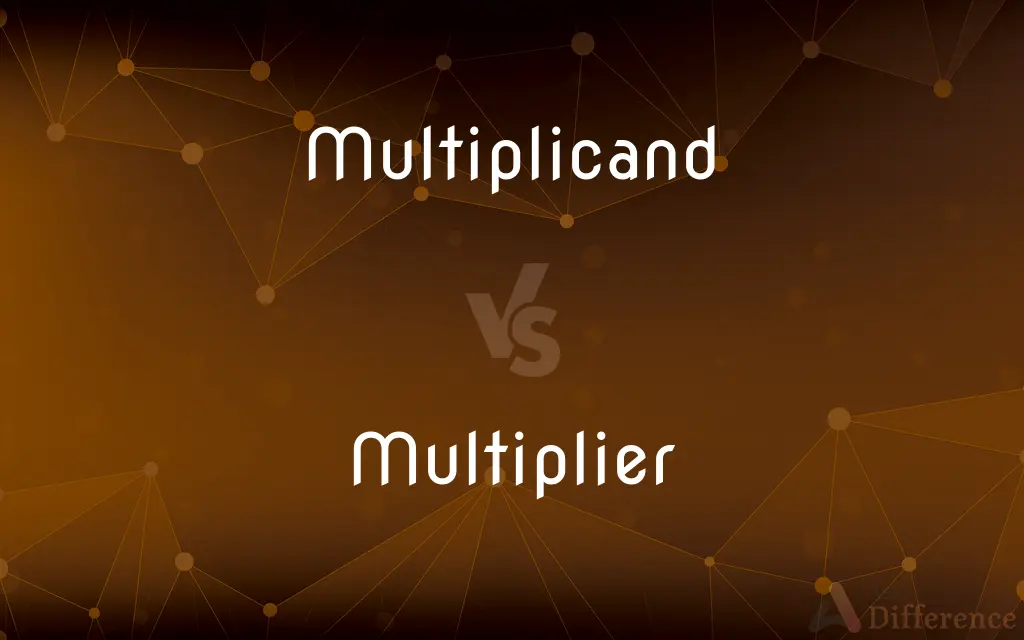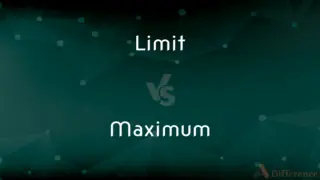Multiplicand vs. Multiplier — What's the Difference?
By Fiza Rafique & Maham Liaqat — Updated on March 18, 2024
The multiplicand is the number being multiplied, while the multiplier dictates how many times the multiplicand is added to itself.

Difference Between Multiplicand and Multiplier
Table of Contents
ADVERTISEMENT
Key Differences
The multiplicand is typically the first number in a multiplication equation, representing the quantity to be multiplied. On the other hand, the multiplier is positioned second and indicates the number of times the multiplicand should be added together.
Multiplicands can be any number, integer, decimal, or fraction, serving as the base of the multiplication process. Whereas, multipliers, although also versatile in number form, essentially act as the repetitive factor in the equation, determining the scale of multiplication.
In the equation form 'a × b = c', 'a' is the multiplicand, showing the starting value. Conversely, 'b' is the multiplier, illustrating how many times 'a' is compounded upon itself to reach 'c'.
Understanding the role of multiplicands is crucial in visualizing the foundational value in multiplication, while recognizing multipliers is key to grasping the concept of repeated addition or scaling.
The position of multiplicand and multiplier can be interchanged without affecting the product, showcasing the commutative property of multiplication. However, in educational settings, the multiplicand is often presented first to establish a base value for learners.
ADVERTISEMENT
Comparison Chart
Definition
The number being multiplied in an equation.
The number that dictates the multiplication factor.
Position in Equation
Typically first.
Typically second.
Role in Multiplication
Represents the base quantity to be multiplied.
Indicates how many times the base quantity is added to itself.
Variability
Can be any number (integer, decimal, fraction).
Can also be any number, but acts as the repeat factor.
Educational Focus
Taught as the foundational value in multiplication.
Emphasized for understanding scaling and repeated addition.
Compare with Definitions
Multiplicand
The number to be multiplied.
In 4 × 3, 4 is the multiplicand.
Multiplier
The number that multiplies another.
In 6 × 2, 2 is the multiplier.
Multiplicand
Central to understanding multiplication.
Recognizing the multiplicand is crucial for solving 9 × 4.
Multiplier
Can be any numerical form.
In 4 × 1.5, 1.5 acts as the multiplier.
Multiplicand
The base value in multiplication.
The multiplicand, 5, sets the basis for the equation 5 × 2.
Multiplier
Its position is typically second but flexible.
Despite being the second number, 4 in 2 × 4 is the multiplier.
Multiplicand
Can be a fraction or decimal.
In 0.5 × 8, 0.5 is the multiplicand.
Multiplier
Indicates repetition in multiplication.
The multiplier, 3, signifies threefold addition in 2 × 3.
Multiplicand
Not limited by position in an equation.
Although 7 is the first number in 7 × 3, it serves as the multiplicand.
Multiplier
Essential for scaling in multiplication.
The multiplier, 10, scales the value in 1 × 10 significantly.
Multiplicand
The number that is or is to be multiplied by another. In 8 × 32, the multiplicand is 32.
Multiplier
One that multiplies
This old house is a multiplier of expenses.
Multiplicand
(arithmetic) A number that is to be multiplied by another (the multiplier).
In the expression 5 × 3, the "3" is the multiplicand.
Multiplier
(Mathematics) The number by which another number is multiplied. In 8 × 32, the multiplier is 8.
Multiplicand
The number which is to be multiplied by another number called the multiplier. See Note under Multiplication.
Multiplier
(Physics) A device, such as a phototube, used to enhance or increase an effect.
Multiplicand
The number that is multiplied by the multiplier
Multiplier
(arithmetic) A number by which another (the multiplicand) is to be multiplied.
In the expression 5 × 7, the "5" is a multiplier.
The score multiplier increases each time you complete a level of the video game.
Multiplier
(grammar) An adjective indicating the number of times something is to be multiplied.
English multipliers include "double" and "triple".
Multiplier
(economics) A ratio used to estimate total economic effect for a variety of economic activities.
Multiplier
(physics) Any of several devices used to enhance a signal
Multiplier
A coil; when Johann Schweigger in 1820 invented the electric coil, increasing the electro-magnetic field from a single wire, this invention was called a multiplier.
Multiplier
A multiplier onion.
Multiplier
One who, or that which, multiplies or increases number.
Multiplier
The number by which another number (the multiplicand) is multiplied. See the Note under Multiplication.
Multiplier
An instrument for multiplying or increasing by repetition or accumulation the intensity of a force or action, as heat or electricity. It is particularly used to render such a force or action appreciable or measurable when feeble. See Thermomultiplier.
Multiplier
The number by which a multiplicand is multiplied
Common Curiosities
What does a multiplier do?
A multiplier dictates how many times the multiplicand is added to itself in a multiplication process.
How can you identify the multiplicand in an equation?
The multiplicand is typically the first number in a multiplication equation, but it can be any number being multiplied.
Can the multiplicand and multiplier switch places?
Yes, due to the commutative property of multiplication, switching their places does not affect the product.
Is the multiplier always an integer?
No, the multiplier can be an integer, decimal, or fraction, similar to the multiplicand.
Do multiplicand and multiplier have fixed positions in an equation?
No, their positions can be interchanged without changing the product, showcasing multiplication's commutative nature.
Can decimals be multiplicands?
Yes, decimals, just like integers and fractions, can serve as multiplicands in multiplication equations.
What is a multiplicand?
The multiplicand is the number in a multiplication equation that is being multiplied by another number, the multiplier.
Why is understanding the multiplicand important?
Understanding the multiplicand is crucial for grasping the base quantity being multiplied in a multiplication equation.
How is the multiplier related to repeated addition?
The multiplier signifies how many times the multiplicand is to be repeatedly added to itself, embodying the concept of repeated addition.
Can the roles of multiplicand and multiplier be considered interchangeable?
In terms of the multiplication result, yes, but they maintain distinct roles in the conceptual understanding of multiplication.
How does the multiplier affect the multiplication equation?
The multiplier determines the scale of multiplication by indicating how many times the multiplicand is added to itself.
What role does the multiplicand play in multiplication?
The multiplicand represents the foundational value or quantity that is to be multiplied in the equation.
How does the concept of a multiplier expand one's understanding of multiplication?
Understanding the multiplier as a factor that scales or repeats addition of the multiplicand offers a deeper insight into the mechanics of multiplication.
Are multipliers only numbers?
In the context of basic multiplication, multipliers are numerical values that can be integers, decimals, or fractions.
What is the significance of the multiplicand in educational settings?
In educational contexts, the multiplicand is emphasized as the starting point or base value in teaching multiplication.
Share Your Discovery

Previous Comparison
Limit vs. Maximum
Next Comparison
Eighth vs. EightAuthor Spotlight
Written by
Fiza RafiqueFiza Rafique is a skilled content writer at AskDifference.com, where she meticulously refines and enhances written pieces. Drawing from her vast editorial expertise, Fiza ensures clarity, accuracy, and precision in every article. Passionate about language, she continually seeks to elevate the quality of content for readers worldwide.
Co-written by
Maham Liaqat













































